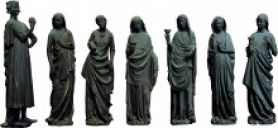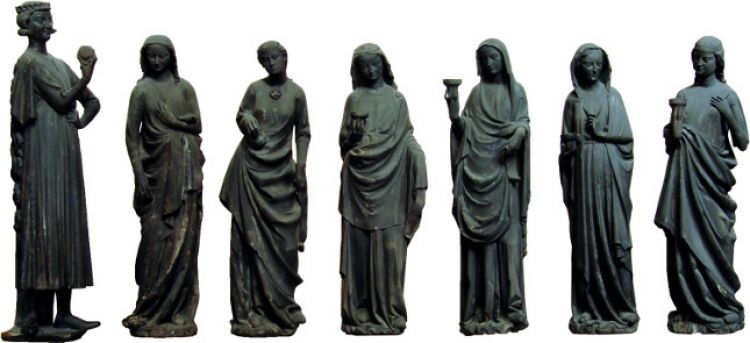The Tempter and foolish Virgins, Wise Virgins

The statuary of the doorways of the west front embodies a full programme of theological teaching. Its iconography is of a richness and consistency that has rarely been equalled, and is quite different from that of other great French cathedrals. The inspirer of this programme, based on the theme of salvation, may well have been the great theologian Albertus Magnus, who is believed to have stayed in Strasbourg around 1260. The statues was carved towards the end of the 13th century, and most specialists divide them into two stylistic groups: those from the “workshop of the virgins” and those from the “workshop of the prophets”. They are a synthesis of various models deriving from the great building sites of Paris and Champagne, but also express tendencies unique to Strasbourg. Scholars have often pointed out their “bourgeois” character, as opposed to the aristocratic style of the statuary of the south door, in particular the figures of Church and Synagogue.
The embrasures of each of the three doorways of the west front accommodate a series of monumental sculptures. Seven sculptures from the lower part of the right-hand doorway are displayed in the museum, illustrating the parable of the wise and foolish virgins. The former are seen being welcomed by their heavenly husband; the latter being seduced by the Tempter. In St. Matthew’s gospel, this parable comes immediately before Christ’s account of the Last Judgement. The Wise Virgins, depicted as smiling girls, hold their lamps upright, while the Foolish Virgins hold theirs symbolically reversed. The Tempter, an elegant young man dressed in the fashion of the day, confidently proffers the apple, but cannot conceal the fact that his back is crawling with toads, lizards and snakes. Though dating back to the 12th century, this subject had previously been depicted only in illuminated manuscripts or small-scale sculptures. Very popular in the Germanic Holy Roman Empire, it was also adopted at around the same time in the cathedrals of Magdeburg, Freiburg im Brisgau and Basle.
